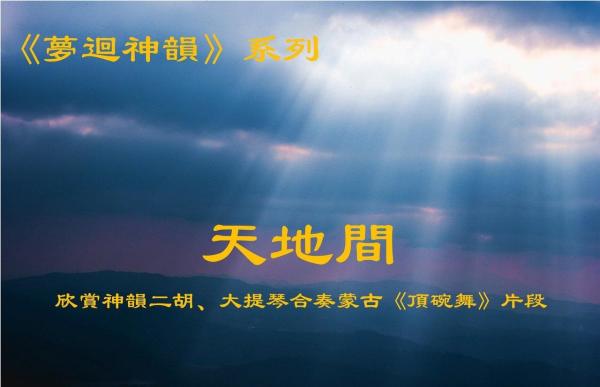
神韻2008年舞蹈《頂碗舞》。(圖片來源:公有領域)
在神韻作品網站上,觀看了一個視頻《二胡、大提琴二重奏—蒙古族頂碗舞片段》,神韻二胡演奏家王真與大提琴演奏家雅克·弗勒,共同演奏一段神韻藝術團2017年的節目:蒙古《頂碗舞》,並展示和講解了他們如何將東西方樂器融合到天衣無縫的地步。藝術家在各自對於東西方樂器的深厚造詣基礎上,還融入了對於蒙古民族音樂的文化底蘊和藝術韻味的深刻體會。短短不到三分鐘的視頻,其中的音樂合奏片段不到1分鐘,但已經給了我美不勝收的心靈觸及。這又引發我極大的興趣,找到神韻作品網站上《頂碗舞》這一期節目完整的4分46秒長度的交響樂演奏。在不看臺上舞蹈的情況下,充分感受到了神韻交響樂,特別是東西方合璧的交響音樂的魅力。感受到音樂本身給舞蹈提供了一個更大、更豐富、更加多維的舞臺,為舞者提供的是一個天造地設的更加美好的天地。音樂的世界裡,看不見舞蹈,卻聽得見舞蹈。音樂中的天地萬物,看似無人,卻處處有人。音樂有空,卻給人提供了最大的活動空間;音樂有無,卻給人提供了應有盡有的自由;音樂有花,花開、花落、花飛都記載著人生的軌跡;音樂有草,記載著人類的奔忙或舞蹈的脚印;音樂有風,保存著人舞者的每一個舞蹈動作;音樂有云,收集著人類的氣息、人間的色彩;音樂有群山,回蕩著人們的歌聲;音樂有湖水,映記著人們的舞姿……交響樂豐富的内涵用千言萬語難以名狀。這裡僅就這其中不到一分鐘的二胡和大提琴兩種樂器合奏的部分,以詩歌來表達個人有限的觀感。
二胡聲起月朦朧,轉眼雲開照夜空。
一片天心霜雪落,光臨大地伴秋風。
提琴隨響野茫茫,一顫弦歌九曲腸。
夜色如水草如浪,風吹草低見牛羊。
天高地廣風中草,地久天長人易老。
何故人活天地間?天經地義何人曉?

交響樂豐富的内涵用千言萬語難以名狀,僅以詩歌來表達個人有限的觀感。(圖片來源:專欄作家李唐風)
Below is the English Translation by the ChatGPT:
[Dreams Return with Shen Yun]Series:Between Heaven and Earth
—Reflections on the Shen Yun Erhu and Cello Duet of the Mongolian“Bowl Dance”
By Li Tangfeng
On the Shen Yun Creations website,I watched ashort video titled“Erhu and Cello Duet—Mongolian Bowl Dance Excerpt.”It features Shen Yun’s erhu musician Wang Zhen and cellist Jacques Forestier performing apiece from Shen Yun Performing Arts’2017 program:the Mongolian“Bowl Dance.”They also share how they seamlessly merge Eastern and Western instruments.The musicians draw not only from their deep mastery of their respective traditions but also from their profound understanding of Mongolian musical culture and artistry.
Though the entire video is less than three minutes,and the actual duet segment under one minute,it delivered astunning spiritual impact.Inspired,I sought out the full 4-minute-46-second symphonic version of“Bowl Dance”on the Shen Yun Creations site.Even without watching the dance itself,I was fully immersed in the brilliance of Shen Yun’s symphony orchestra,particularly its fusion of East and West.The music provided dancers with astage not just grander,but more vivid and multidimensional—a heaven and earth crafted perfectly for beauty.
In music,though we do not see the dance,we can hear the dance.In the musical world,things seem uninhabited,yet humanity is felt everywhere.Music contains emptiness,yet grants boundless freedom;music may seem abstract,yet contains all things needed.It holds blooming flowers,their blooming,falling,and flying recording life’s path;grass that traces the rush of human steps or dancers’footprints;wind that preserves every movement of the dancers;clouds that collect the breath and colors of the human world;mountains that echo with human song;and lakes that reflect the dancers’forms.The richness of symphonic music cannot be fully expressed in words.
Here,I’ve chosen to express just the erhu and cello duet—less than aminute—in the form of ahumble poem:
When the erhu rises,the moon is veiled,
A breath—the clouds part,and night is unveiled.
From heaven’s heart,frost and snow descend,
Bringing their glow with the autumn wind.
The cello joins in with the wild expanse,
A trembling string stirs the soul’s deep dance.
The night flows like water,the grass like waves,
The wind brushes low—and sheep emerge from the haze.
The sky is vast,the earth is wide,the grasses wave in wind and time.
Time moves on,and man grows old—
But why must we live between heaven and earth?
Who truly knows what destiny holds?
